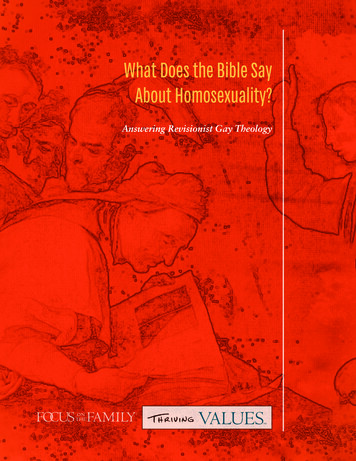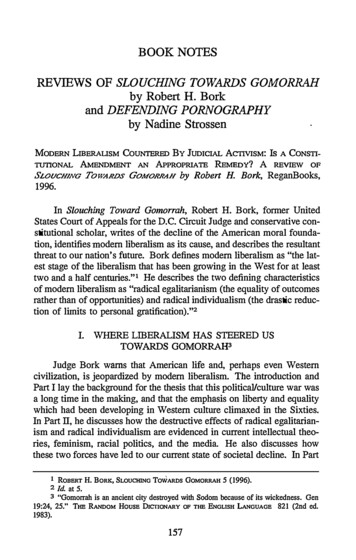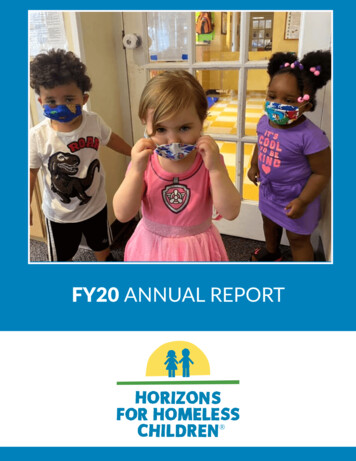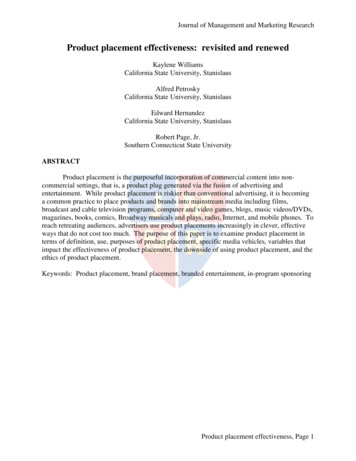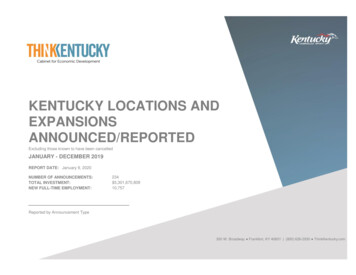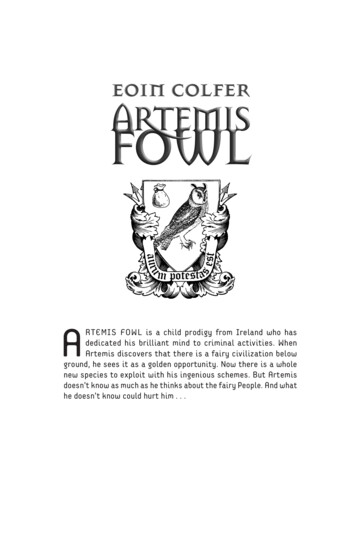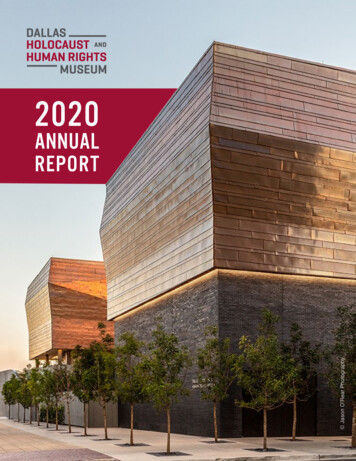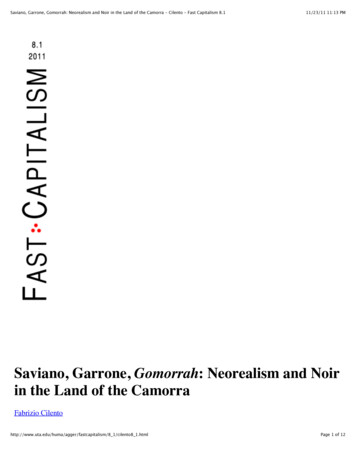
Transcription
Saviano, Garrone, Gomorrah: Neorealism and Noir in the Land of the Camorra - Cilento - Fast Capitalism 8.111/23/11 11:13 PMSaviano, Garrone, Gomorrah: Neorealism and Noirin the Land of the CamorraFabrizio m/8 1/cilento8 1.htmlPage 1 of 12
Saviano, Garrone, Gomorrah: Neorealism and Noir in the Land of the Camorra - Cilento - Fast Capitalism 8.111/23/11 11:13 PMUnidentified Narrative ObjectsIn the opening chapter of Gomorrah, Roberto Saviano describes the arrival of shipping containers from Chinaloaded with dead bodies spilling out in the port of Naples. “The hatches, which had been improperly closed,suddenly sprang open, and dozens of bodies started raining down. They looked like mannequins. But whenthey hit the ground, their heads split open as if their skulls were real. And they were.” Just a few lines later,Saviano reveals his source: “The port crane operator covered his face with his hands as he told me about it,eyeing me through his fingers. As if the mask of his hands might give him the courage to speak. He’d seenthe bodies fall ” (2006:3-4).This example illustrates how, throughout his personal journey into the realm of the Neapolitan-basedorganized crime system called Camorra, Saviano does not distinguish the author’s subjective gaze from thatof his unofficial sources. Instead, he creates an eye/I dynamic, that is, an oscillation between centered andautonomous subjectivity. The incorporation of unanticipated viewpoints such as that of the port craneoperator allows Saviano to break the boundaries between the journalistic inquest, a whistleblower’s account,and the political pamphlet. To embrace multiple identities is an ethical position, a rejection of a politicallycorrect point of view on the Italian Southern Question.Portrayed as an open, infected wound, the port of Naples constitutes a perfect location for revealing theglobal dealings of the Camorra. Such a setting is revelatory of the influence of American film noir and hardboiled literature on Saviano. Recent studies by Gyan Prakash and Edward Dimendberg1 have discussed filmnoir’s preoccupation with the urban landscape and dystopic images of the modern city. The liminal space ofthe port is topical in the history of noir: from the arrival of the freighter La Paloma in San Francisco’s dock inThe Maltese Falcon (John Huston, 1941) to films such as Port of New York (Laslo Bendek, 1949), to morerecent neo-noirs such as The Usual Suspects (Bryan Singer, 1995).The link with a noir imaginary is the peculiarity of Gomorrah and possibly a key factor in its success whencompared to the large body of nonfiction reportages or academic books on organized crime. While a book onthe Camorra would typically sell between 5,000 and 10,000 copies and rarely crossed the regional borders ofCampania, Gomorrah became an instant bestseller translated in over fifty languages. On a contextual levelGomorrah is not radically different from previous books on the topic, which describe the illegal trafficking ofthe Camorra in similar ways. In fact, Saviano was accused of plagiarism in 2009 by freelance reporterSimone di Meo and by the local newspaper Corriere di Caserta (and then acquitted by the Naples courts thefollowing year). Caught in the fiction vs. nonfiction debate on the nature of the book, critics overlook theauthor’s stylistic choice of narrating actual events by adopting the language of global noir. The influence ofnoir on Saviano is clarified and even accentuated by Matteo Garrone’s cinematic adaptation of Gomorrah.Garrone stated in numerous interviews that he first experienced a sinister attraction to the hyperreal ‘images’that the book presents, such as the Chinese bodies with open skulls looking like mannequins, and only laterbecame preoccupied with Saviano’s overall analysis of the crime system. While the book is an epic attempt atdescribing the larger-than-life apparatus of an all-invasive conspiracy, and to coherently represent fragmentedpieces of the unknown, the film is a complementary tool that proceeds by giving autonomy to a series ofminor, and apparently secondary episodes. These scenes portray the invisible everyday life under the statewithin-the state that criminality has constructed in the outskirts of Naples.Because Saviano’s book is neither a novel nor reportage, neither narrative nor journalism, in New Italian EpicWu Ming defined it an UNO, that is “Unidentified Narrative Object” (2009: 12). Saviano uses police reports,judicial documents, and personal experiences to depict Naples’ organized crime operations within thehttp://www.uta.edu/huma/agger/fastcapitalism/8 1/cilento8 1.htmlPage 2 of 12
Saviano, Garrone, Gomorrah: Neorealism and Noir in the Land of the Camorra - Cilento - Fast Capitalism 8.111/23/11 11:13 PMglobalized economy. Again, what is unique is that Saviano blends these technical sources with thestorytelling typical of the hard-boiled school of writing and film noir. This, and not the revelation of thenaked facts, allowed him to reach both a specialist and a vast generalist audience. While there is certainlyinterest in the organized crime issue, not everyone is willing to decipher the heavy technicalities, to spot therecurrent falsifications in official documents, or to climb the bureaucratic jargon’s wall of ice. Savianomanaged to find a remarkable balance between the necessary evil of technicalities and an evocative noirlanguage (which involve gruesome details and succinct anecdotes).Saviano’s narrative voice resembles that of an investigator who is both fascinated and repelled by crime. Attimes the author embodies an ultra-analytical and ultra-educated version of Sam Spade or Philip Marlowe, orbetter, of a Sam Spade and Philip Marlowe with an unprecedented sociopolitical awareness that leads intoactivism. But the author’s voice in the book is also enigmatic at times. Some passages describe new lethaldrugs being tested on heroin addicts, an indifferent crowd passing by the wounded dying in the streets, acrossfire killing of a fourteen-year-old girl, and primitive rituals for recruiting young teenagers into the crimeorganization and testing their courage. How was Saviano able to see all this? Who is the narrating “I”? Arewe reading a piece of journalism, or a novel disguised as such? According to Wu Ming, this sort of questionleads Gomorrah into the UNO. In order to understand this, as well as the transition from Saviano’sGomorrah to its film adaptation by Garrone, I propose to expand on the concept of Wu Ming’s UNO, arguingthat it should not be limited to literature, but can also be extended to Saviano himself as a result of hisunprejudiced use of different media. The author himself can be considered an UNO, a ubiquitous storytellerin the age of media convergence and participatory culture. Saviano received numerous death threats, and wasforced to live in seclusion under constant government protection, but this did not prevent his provocativeideas from simultaneously circulating on different media, throughout national newspapers, television, socialnetworks, literary blogs, platforms such as YouTube, and theatrical and cinematic adaptations.Garrone’s film appears as an important extension of an innovative communication strategy rather than a closere-proposition of the original material. When Garrone started shooting Gomorrah, Saviano had alreadysuccessfully raised awareness about the Camorra. Thus, the film is able to bypass much of the first handinformative and pedagogic material and to concentrate on a minimalist rather than “epic” approach.Gomorrah is an ambitious film that overcomes the present impasses of Italian neorealist heritage by blendingit with noir moral ambiguity and visual culture. For this reason, Garrone’s work is revelatory of how todayfilm noir is a not a uniquely American cinematic phenomenon, but rather a transnational and transgenericone, capable of crossing national boundaries and dramatizing the crisis of urban peripheries.Saviano in the Age of Convergence CultureAfter the publication of Gomorrah, Saviano appeared several times on television, interviewed by well-knownjournalists and talk show hosts such as Enzo Biagi (Rotocalco televisivo), Michele Santoro (Annozero),Enrico Mentana (Matrix), Daria Bignardi (Le invasioni barbariche and L’era glaciale), and Fabio Fazio (Chetempo fa and Vieni via con me, which he co-hosted). Saviano was also interviewed by Nazanine Moshiri onAl Jazeera’s People & Power (where he was labeled “the Italian Salman Rushdie”), by Laurence Pollard onBBC’s Culture Show, and by NOS Netherlands, the Dutch national television. His communication strategyrecalls that employed by Pier Paolo Pasolini, another intellectual who wanted to be seen protesting televisionon television and who used paid time to stage his ferocious polemics against the so-called “economicmiracle” (1959-1964) and its afterwards.2 Saviano’s monologues and interviews in the era of SilvioBerlusconi’s failed “Italian miracle” and conflicts of interest are often self-reflexive, with the result that themedium itself is put on trial for the distorted information it provides. Organized criminality had never /8 1/cilento8 1.htmlPage 3 of 12
Saviano, Garrone, Gomorrah: Neorealism and Noir in the Land of the Camorra - Cilento - Fast Capitalism 8.111/23/11 11:13 PMbeen addressed with such precision, frontally challenged or described in such detail on TV. It is notsurprising that these epiphanies made headlines on national newspapers, and that in the public opinion thewriter’s persona quickly became inseparable from that of the public storyteller. This was also confirmedwhen in 2009 Saviano received an honorary degree in Communication and Art Teaching from Milan’sAcademy of Fine Arts in Brera. Saviano dedicated the awards to the people from the south of Italy living inMilan, generating subsequent polemics with senator Roberto Castelli from the Northern League.Saviano quickly transcended the literary object, or at least has demonstrated Gomorrah’s capacity to existsimultaneously inside and outside the page. Seen in this light, Gomorrah appears to be an UNO not only forthe literary techniques effectively described by Wu Ming, but especially for Saviano’s capacity to transform abest-seller into a fluid work in progress that each time resists its detractors by refining its own arguments, orby choosing new objectives. Thus, the legitimate critiques regarding the role of the publisher (whichemphasize the rigorous work of editor Helena Janeczek at Mondadori) or the accusations of plagiarism andinexactitudes are marginalized, since they miss the main point of Saviano’s communication strategy.Furthermore, in the age of media convergence and participatory culture, the TV appearances continue tosuccessfully circulate across different systems, once they are uploaded on platforms such as YouTube andsocial networks such as Facebook. Today Saviano is a writer as much as he is a ubiquitous storyteller, forsecurity reasons physically separated from the community in which he grew up, but virtually present in itmore than ever. He is a catalyst able to generate in-depth discussion and to bring to light what had been,before the “Gomorrah effect,” conveniently removed from the Italian civil conscience for decades. Anotherproof of Saviano’s pursuit of this strategy lies in the fact that he has chosen the dynamic essay form over thenovel for The Beauty and Inferno (2009) and Vieni via con me (2011), which contains the stories that werepresented in the TV program he co-hosted. While of course he may publish another UNO novel in the future,what is remarkable about Vieni via con me is that Saviano adapted texts originally conceived for televisionmonologues into a book, and not vice-versa.Gomorrah Between Neorealism and Neo-NoirThe elliptical and episodic cinematic adaptation of Gomorrah is the most significant step in itsmetamorphosis into a trans-media text. Garrone successfully blends Italian neorealism with film noir and itssci-fi derivations, creating another unique, unidentified object both in the panorama of contemporary Italiancinema and that of global neo-noir. It has been said that classic film noir has been conceived ‘under theinfluence’ of German expressionism, French poetic realism, and Italian neorealism. Historically, the fruitfulrelationship between noir and Italian cinema is as old as Obsession (1943) - Luchino Visconti’s protoneorealist ‘dislocation’ of James M. Cain’s hard-boiled novel The Postman Always Rings Twice (1934). Thisis an early symptom of how the phenomenon of film noir is heterogeneous, polyglot, and indeedcosmopolitan. “Noir sensibility has, from the 1930s to the present, articulated forms of emotional attachmentbeyond one’s country of origins, and in its special relationship to a putatively universal ‘modern man’ forgedin the shadow of global catastrophe” (Fay and Niedland 2010:2). Obsession’s alienated characters are theproduct of exploitive and corrupt domestic relationships. Disguised as another image of American decadenceand corruption, the foreignness of Cain’s literary source allowed Visconti to indirectly critique the Fascistmodel of the patriarchal family as portrayed in the so-called “white telephones” films, a series of romanticcomedies with elegant scenarios and aristocratic protagonists removed from the struggles of everyday life.In turn, it would be difficult to overestimate the influence of neorealism on subsequent American film noir.This emerges in some of the most representative post-World War II American noirs such as Knock on AnyDoor (Nicholas Ray, 1949). Ray’s film focuses on the dismal aspects of life and at times uses sm/8 1/cilento8 1.htmlPage 4 of 12
Saviano, Garrone, Gomorrah: Neorealism and Noir in the Land of the Camorra - Cilento - Fast Capitalism 8.111/23/11 11:13 PMexterior locations rather than studios. Furthermore, it denounces youth criminality (a topic that is also crucialin Gomorrah) as the product of a deranged social environment rather than of intrinsic human evil.Gomorrah demonstrates how this tradition of elective affinities between Italian art cinema and film noir isstill a vital tendency. Garrone’s film is outstanding when compared to numerous the anti-mafia and antiCamorra films produced in the last fifty years – a tendency animated by noble intents but at times plagued bydisappointing results.3 Instead, Gomorrah is informed by Paul Schrader’s definitions of noir as “an uneasy,exhilarating combination of realism and expressionism” (1972:584), and “a moral vision of life based onstyle” (1972:591). As Porton wrote in a recent issue of Cineaste:“Trained as a painter, Garrone possesses one of the sharpest eyes in contemporary cinema.Gomorrah teems with memorable compositions that offer visual equivalents to Saviano’s moreanalytical perspective: the grotesque, if absurd, spectacle of naked gangsters tanning themselvesin a solarium before a violent outburst interrupts their leisure as the film opens; a car swervingthrough a statuary park after another ghastly shoot out; two crazed kids emptying their machineguns on a beach; and a hapless truck driver splattered with toxic sludge” (2009:2).If thematically Gomorrah pushes the limits of noir’s pessimistic view of society, stylistically it involvesnumerous low-angle shots and an abundant use of the chiaroscuro technique. The latter constitutes aliberating choice that breaks any stereotypical view of Naples as “sun city.” In this way Garrone’s Naplesechoes the Los Angeles depicted in movies such as Double Indemnity (Billy Wilder, 1944) and Blade Runner(Ridley Scott, 1982). In many long sequences such as the initiation ritual in a cave of the Camorra’s youngmembers, the city’s outskirts appear shady, rebellious, dysfunctional, entrenched in ecological and racialcrises, and above all paralyzed by organized criminality’s internal wars. Moral and political authorities havevanished from the cursed territory with criminality rising to become “the system.” This is perfectly integratedin the everyday life of a land in which victimization of the inhabitants is not the exception but the norm. InGomorrah, monstrosity is something banal, almost natural (the only glimmer of hope for an alternate way oflife appears in the few seconds in which a young character called Roberto rejects crime’s logic and abandonsthe organization).This appears to be an extension of a process initiated by classic noirs, which already presented a harshaccount of capitalism. Film noir, with its private eyes, rogue cops, white-collar criminals, and femme fatales,reveals the collateral effects of American life. The criminal world cannot be conveniently isolated within theurban underworld as in the old gangster films of the 1930s because it flourishes everywhere. Every man is apotential criminal, and not even a quiet, anonymous life in suburbia is immune from violence. Film noir alsoundermines the cliché that in America there is always a second chance. “There is no reprieve in film noir, butcharacters just keep paying for their sins. In Joseph Lewis’ Gun Crazy (1950), the focus was not on thevictim but on the criminals themselves. One is compelled to share their fear and even their exhilaration.There was no moral compass anymore, to the point that even the audience is pulled into the action andbecomes an accomplice” (Scorsese in A Personal Journey Through American Movies, 1995). What noirpointed at was a “moral denunciation in the name of basic values among which one finds the privilegeaccorded to relations of proximity and respect for ideal virtues to the detriment of material values,” (Vernet1993:36) which is often resolved in a courtroom or a police station. Gomorrah shares many of these samecharacteristics, from the lack of reprieve and a focus on the criminals, to the stylized lighting andcomposition. However, in the apocalyptic Gomorrah the traditional morals are absent, and there are no basicshared values to defend.In transforming a 300-page book that contains an impressive amount of first-hand information into a twohttp://www.uta.edu/huma/agger/fastcapitalism/8 1/cilento8 1.htmlPage 5 of 12
Saviano, Garrone, Gomorrah: Neorealism and Noir in the Land of the Camorra - Cilento - Fast Capitalism 8.111/23/11 11:13 PMhour film, Garrone and a small group of screenwriters, which initially included Saviano, deliberatelyrearrange chosen facts and proceed by subtraction. While the book has an international scope that involvesRussia, Belarus, Scotland, the United States, Spain, the Middle East, and Colombia, the film follows just fivemain story lines. The protagonists are Pasquale, a master tailor who works in the black market to produceclothing for the high fashion labels that will go on to fit Hollywood stars; Don Ciro, whose duty is to deliverpayments to the families of the accomplices who are in prison; Marco and Ciro, two teenagers obsessed withScarface (Brian De Palma, 1983) who take Tony Montana as a role model; Maria (named Carmela Attrice inthe book), murdered with the involvement of the thirteen-year old Totò for the betrayal of her secessionistson; and finally Franco, a toxic waste management specialist, and his young helper, Roberto. Through abrilliant montage á la Robert Altman,4 Garrone blends these stories together, touching upon different pointsof the Camorra’s socioeconomic reach in a series of short cuts that develop simultaneously and at timesintersect.The common denominator of these stories lies in their allegorical value. The characters are executioners andat the same time victims manipulated by invisible forces. They live the illusion of cutting their own dealswith the crime system, of bending its savagery to their own ends. Garrone focuses on the wretched of theearth: Camorra’s daily laborers and foot soldiers operating in the suburbia. While minor in the book, thesecharacters are elevated to protagonists. Despite the limited scope of the film, the idea of the Camorra as aglobal phenomenon is suggested through the presence of Nigerian and Chinese mafia (FIG.1), and by thesuperimposed text that appears at the end of the film, stating that the Camorra has invested in the rebuildingof the Twin Towers site.FIG.1. Xian and the Chinese driving the tailor Pasquale to an illegal factory.A notable absence in the adaptation is that of Saviano’s persona and his narrative “I” that emerges in manyintrospective chapters of Gomorrah, which could have been easily adapted in the film as a voice over. AsJameson pointed out in “Synoptic talism/8 1/cilento8 1.htmlPage 6 of 12
Saviano, Garrone, Gomorrah: Neorealism and Noir in the Land of the Camorra - Cilento - Fast Capitalism 8.111/23/11 11:13 PM“Both pulp or hard-boiled detective stories and film noir are indeed structurally distinguished bythe fundamental fact that the voice-over, which signals in advance the closure of the events to benarrated just as surely as it marks the operative presence of an essentially radio aesthetic whichhas no equivalent in the earlier novel or silent cinema It is at any rate clear that the voice overof the hard-boiled detective offers a specifically radio pleasure which must be paid for by akind of closure that allows the novels past tenses to resonate with doom and foreboding andmarks the detective’s daily life with the promise of adventure” (1993:36-37).However, since Gomorrah is caught in a never-ending negative spiral dynamic, the closure of events broughtby an authoritative voice becomes impossible. In Gomorrah there is no crime case to solve, no failure of theinstitutions to defend shared values, no struggle of an innocent individual, and thus no need for narrativeclosure. Everyone is, at a different level, involved and an accomplice in the system. Furthermore, we haveexplored how the narrative pleasure of Saviano’s voice-over contextualizing shocking events has been asymbolic Trojan horse through the medium of television. As theorist Michel Chion in Audio-Vision haspointed out, television is essentially an auditory rather than a visual medium (1990:37). In order to satisfy hissociopolitical agenda, Saviano’s monologues, the ultimate ‘voice-over’ of our civil conscience, audaciouslyconstruct a narration within the facts for his audience rather than simply commenting about the facts. Instead,Garrone has declared numerous times that he is not animated by such pedagogic and openly politicalimpulses, privileging a stylized approach to the events instead.Garrone’s film problematizes cinema’s representation of organized criminality, emphasizing that the battle ofthe Camorra is not fought exclusively at an economic level, but even more so at an imaginary level. In thechapter “Hollywood,” Saviano describes how the resistible rise of a crime boss depends on the ability toinstill a mix of terror and admiration in the local people through a vernacular appropriation of global cinemastars (which often becomes an involuntary parody). When it comes to the Camorra, it is life that imitatescinema, and not vice-versa: killers changed their way of holding a gun to imitate Quentin Tarantino’scharacters, a female boss nicknamed Nikita has bodyguards who dress in fluorescent yellow outfits like UmaThurman in Kill Bill (2003), and Cosimo di Lauro’s clothes are reminiscent of those of Brandon Lee’s in TheCrow (Alex Proyas, 1994). New generations of Camorra mimic cinematic villains in order to construct theirown legend and present themselves as local heroes able to keep the order and to redeem the cursed territoriessurrounding Naples.The idea of de-glamorizing Camorra is crucial in Garrone’s adaptation: there are no elaborate weddings orsummit meetings, but only a squalid, day-to-day struggle for survival. The incommensurable distancebetween Hollywood characters and the protagonists of Gomorrah emerges in the sequence in which Marcoand Ciro quote passages of Scarface in an abandoned building at the city’s edge (which belonged to the bossWalter Schiavone, who commissioned a replica of Tony Montana’s villa as seen in De Palma’s film). Ratherthan showing the mafia bosses in the film, Garrone concentrates on those at the bottom of the hierarchy.However, despite the fact that Gomorrah constitutes a new frontier in the brutal and raw representation ofcrime, there is no doubt that the film has appealed to younger generations of criminals. This hypothesis hasbeen recently supported by a Northern Italian gang of teenagers in Quarto Oggiaro (Milan), whose membershave been caught mimicking Marco and Ciro’s poses and behaviors. Criminal teenagers shot cellular phonepictures of themselves in their underwear with a Kalashnikov pointed at the camera, an open homage thefamous beach scene of Gomorrah (FIG. 8 1/cilento8 1.htmlPage 7 of 12
Saviano, Garrone, Gomorrah: Neorealism and Noir in the Land of the Camorra - Cilento - Fast Capitalism 8.1http://www.uta.edu/huma/agger/fastcapitalism/8 1/cilento8 1.html11/23/11 11:13 PMPage 8 of 12
Saviano, Garrone, Gomorrah: Neorealism and Noir in the Land of the Camorra - Cilento - Fast Capitalism 8.111/23/11 11:13 PMFIG. 2-3. Life imitates cinema even when it comes to Gomorrah. Two cellular phone portrayals of a memberof the Quarto Oggiaro gang.Although never complacent, Garrone is undoubtedly fascinated with the recent anthropological mutations ofNeapolitan petty criminals. The rural background and association with banditry that marked the criminals afew decades ago has been washed away by the economic miracle, and supermodernity of the Neapolitansuburbia is surprising to international audiences. New generations of criminals, both in Gomorrah and in thepictures above, present a buzz haircut rather than a traditional hat, tattooed muscles pumped up by steroids,knockoff fashions, and the latest cell phones. To furnish an aesthetic portrayal of petty criminals is the projectof the whole adaptation, which is not animated by the neorealist impulse to convey a pedagogic message ornoir’s need to solve the case.What Garrone adopts from neorealism instead is a rigorous documentary-like style which emerges in thenumerous sequences shot by a handheld camera. The operator is Garrone himself, who brings us unusuallyclose to the criminals and in doing so incessantly interrogates what degree of “reality” is developing in frontof the camera. Garrone creates a compelling link with the book by shooting on location in Scampia. Situatedin the Neapolitan suburbia, the town is the largest open-air drug market in the world. In 2004 a bloody gangwar erupted in the area between the controlling Di Lauro clan and a breakaway faction. The cinematic crewof Gomorrah aimed to reconstruct some of these dramatic events and was the first one allowed in theterritory, which is considered a fortress in the hand of criminality, or a state within the state. However, at thattime there was a tacit truce, a dynamic somewhat analogous to a dictatorship allowing UN inspections in theirterritories. In addition, for some drug dealers who appeared in the film playing themselves, Gomorrahrepresented a unique chance to fulfill their dream of becoming part of the cinematic world. Afterward, fourwere arrested for their crimes.“They were happy to participate in the film and share their experiences. To a certain extent, theywere the first audience for the film, since they were always behind the monitor as I was shooting.They could tell me if a certain detail was correct. When I was shooting the scene with Totó andthe drug dealer, the camera was at the top of the building. During the scene, an actual drugdealer, thinking the scene was real, came from the back to engage in an actual drug transaction.Then the drug dealer came and saw the scene on the monitor and advised us on how a drug dealshould be conducted. In instances such as these, I was very concerned to get all the specificscorrect Since they had grown up in this environment, they weren’t aware that it was anythingabnormal” (Garrone in Porton 2009:6).The heritage of masterpieces such as Roberto Rossellini’s so-called “war trilogy” (1945-48), SalvatoreGiuliano (Francesco Rosi, 1961), and The Battle of Algiers (Gillo Pontecorvo, 1966), emerges in long uncutsequences, the use of natural lighting and of dialect, a degree of guided improvisation, and a mix ofprofessional (the star Tony Servillo) and non-professional actors on set, chosen according to the principle oftypecasting. These choices are particularly effective in the scenes set in “Le Vele,” the infamous pyramidshaped complex surrounded by dioxin-sprayed fields, a symbol of the country’s different economicsynchronies and of the permanence of the Third World within the First World. Here we finally visualize whatwe had only read in Saviano’s work: the Neapolitan junkspace, the convenient black hole which hides whatthe Northern part of the peninsula does not want to see, eat, or above all, breathe.Garrone gives a personal touch to the original material when he mixes the neorealist heritage with a sci-fi andneo-noir aesthetic. This conveys the uncanny feeling of incredulity that one experiences while readingGomorrah for the first time, since Saviano’s reconstituted reportage seems to come from another, sm/8 1/cilento8 1.htmlPage 9 of 12
Saviano, Garrone, Gomorrah: Neorealism and Noir in the Land of the Camorra - Cilento - Fast Capitalism 8.111/23/11 11:13 PMplanet. The film’s prelude is programmatic in this sense, and it reveals that Gomorrah will not be yet anotherneo-neo-neorealist film,5 but a work that revitalizes the national tradition from within. In order to do soGarrone opportunistically employs the use of lighting and
The link with a noir imaginary is the peculiarity of Gomorrah and possibly a key factor in its success when compared to the large body of nonfiction reportages or academic books on organized crime. While a book on the Camorra would typically sell between 5,000 and 10,000 copies and rarely crossed the regional borders of
